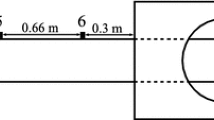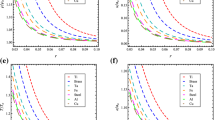Abstract
Graphical solutions of shock reflections in gases have long been used to gain insight into such phenomena. These shock polar solutions provide a simple means of visualizing the complex nonlinear nature of shock wave interactions. This methodology, however, is not limited to the treatment of an ideal gas. While the framework can be extended to a completely general equation of state, the emphasis here will be on the description of oblique shocks in a hydrodynamic Mie–Gruneisen solid. The oblique shock relations for the principal Hugoniot, second shock Hugoniot, and release isentrope are presented and used to solve two different shock reflection problems. First, the oblique shock reflection from an inclined interface is examined using the shock polar methodology. Specifically, the shock interactions at a copper and beryllium oblique interface are addressed to compare the shock polar methodology with a recent study which utilizes a Lagrangian analytical approach in conjunction with numerical simulations. The second problem examined is the so-called Mach lens configuration, which can be used to generate a steady Mach reflection. Shock polar solutions are generated for a copper target using various confinements and compared to numerical simulations. Similarly, an iron target is examined in which the resulting polymorphic phase transition can also be described through the shock polar methodology.












Similar content being viewed by others
References
Bleakney, W., Taub, A.H.: Interaction of shock waves. Rev. Mod. Phys. 21(4), 584–604 (1949)
Hornung, H.: Regular and Mach reflection of shock waves. Ann. Rev. Fluid Mech. 18, 33–58 (1986)
Menikoff, R., Plohr, B.: The Riemann problem for fluid flow of real materials. Rev. Mod. Phys. 61(1), 75–130 (1989)
Rice, M.H., McQueen, R.G., Walsh, J.M.: Compression of solids by strong shock waves. In: Seitz, F., Turnbull, D. (eds.) Solid State Physics, vol. 6, pp. 1–63. Academic Press, New York (1958)
Courant, R., Friedrichs, K.O.: Supersonic Flow and Shock Waves. Springer, New York (1948)
Davison, L.: Fundamentals of shock wave propagation in solids. Shock wave and high pressure phenomena. Springer, Berlin (2008)
Liepmann, H.W., Roshko, A.: Elements of Gasdynamics. Dover Publications, Wiley (1957)
Loomis, E., Swift, D.: Oblique shock waves incident on an interface between two materials for general equations of state. J. Appl. Phys. 103(023518) (2008)
Forsythe, G.E., Malcolm, M.A., Moler, C.B.: Computer Methods for Mathematical Computations. Prentice-Hall, Englewood Cliffs (1976)
Samtaney, R., Meiron, D.: Hypervelocity Richtmyer–Meshkov instability. Phys. Fluids. 9(6), 1783–1803 (1997)
Samtaney, R., Zabusky, J.: Ciculation deposition on shock-accelerated planar aand curved density-stratified interfaces: models and scaling laws. J. Fluid Mech. 269, 45–78 (1994)
Samtaney, R., Ray, J., Zabusky, J.: Baroclinic circulation generation on shock accelerated slow/fast gas interfaces. Phys. Fluids. 10(5), 1217–1230 (1997)
Aslam, T.D., Bdzil, J.B.: Numerical and theoretical investigations on detonation-inert confinement interactions. In: Short, J.M., Maienschein, J. (eds.) The Twelfth Symposium (International) on Detonation, pp. 483–488. San Diego, CA (2002)
Banks, J.W., Henshaw, W.D., Schwendeman, D.W., Kapila, A.K.: A study of detonation propagation and diffraction with compliant confinement. Combus. Theory Model. 12(4), 769–808 (2008)
Fowles, G.R., Isbell, W.M.: Method for Hugoniot equation-of-state measurements at extreme pressures. J. Appl. Phys. 36(4), 1377–1379 (1964)
Adadurov, G.A., Dremin, A.N., Kanel, G.I.: Mach reflection parameters for plexiglass cylinders. ZPMTF 10(2), 126–128 (1969)
Syono, Y., Goto, T., Sato, T.: Pressure enhancement by conically convergent shocks in composite cylinders and its application to shock recovery experiments. J. Appl. Phys. 53(11), 7131–7135 (1982)
Mori, Y., Nagayama, K.: Observation of shock wave convergence or collision induced by shaping of plane shock front in solids. SPIE High Speed Photogr. Photonics. 1801, 357–361 (1992)
Brown, J.L., Ravichandran, G., Reinhart, W.D., Trott, W.M.: High pressure Hugoniot measurements using converging shocks. J. Appl. Phys. 109(093520) (2011)
Brown, J.L.: High Pressure Hugoniot measurements in solids using Mach reflections. PhD Thesis, California Institute of Technology (2011)
Ben-Dor, G.: Shock Wave Reflection Phenomena. Springer, New York (1992)
Hertel, E.S., Bell, R.L., Elrick, M.G., Farnsworth, A.V., Kerley, G.I., Mcglaun, J.M., Petney, S.V., Silling, S.A., Taylor, P.A., Yarrington, L.: CTH: A software family for multi-dimensional shock physics analysis. In: Brun, R., Dumitresce, L.D. (eds.) Proceedings of the 19th International Symposium on Shock Waves, VI, pp. 377–382. Marseille, France (1993)
Taylor, P.A.: CTH reference manual : the Steinberg-Guinan-Lund Viscoplastic model. In: Sandia National Laboratories, Report, SAND92-0716 (1992)
Barker, L.M., Hollenbach, R.E.: Shock wave study of the alpha-epsilon phase transition in iron. J. Appl. Phys. 45(11), 4872–4887 (1974)
Kerley, G.I.: Multiphase Equation of State for Iron. In: Sandia National Laboratories. Report, SAND93-0227 (1993)
Acknowledgments
The research support provided by the Caltech Center for the Predictive Modeling and Simulation of High-Energy Density Dynamic Response of Materials through the US Department of Energy National Nuclear Security Administration under Award Number DE-FC52-08NA28613 is gratefully acknowledged. We would also like to thank Professor Hans Hornung for his useful discussions regarding the application of the shock polar analysis to solid materials.
Author information
Authors and Affiliations
Corresponding author
Additional information
Communicated by N. Thadhani.
Rights and permissions
About this article
Cite this article
Brown, J., Ravichandran, G. Analysis of oblique shock waves in solids using shock polars. Shock Waves 24, 403–413 (2014). https://doi.org/10.1007/s00193-013-0484-1
Received:
Revised:
Accepted:
Published:
Issue Date:
DOI: https://doi.org/10.1007/s00193-013-0484-1




